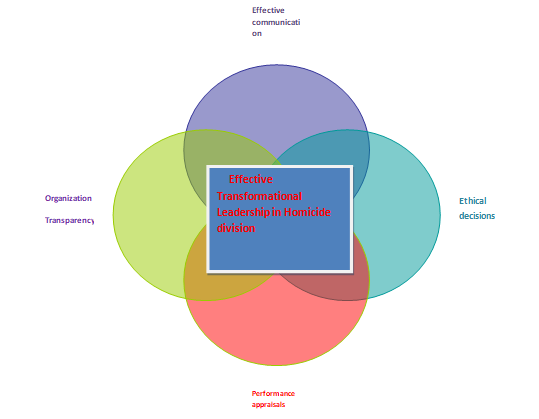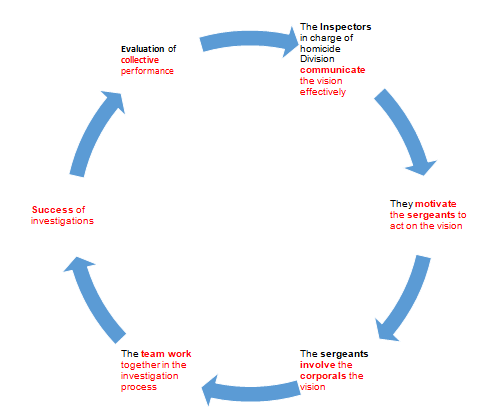Introduction
The literature review is on Police service transformation evaluating the transformation leadership and suitability of transformational leadership in the Homicide Division. In the Police Service, other styles of leadership have prevailed compared to the model of transformational leadership.
Different scholars have argued differently on the appropriateness of transformational leadership in the Police Service, especially in the homicide division a department that deals with cases of homicide on daily basis. This review will examine different arguments on transformational leadership, which are significant in the study.
It will evaluate how to integrate transformational leadership into the division and analyse factors that hamper the transformational leadership and critically assess the effectiveness of implementation, analyse the efficiency of Transformational Leadership, its implication on improvement of organisational performance and make recommendations.
Theoretical perspective
Transformational leadership is a leadership style that involves working together with others (Bass 1998). It creates a situation where the people involved participate in the process of leadership (Bass 1998). The transformation leadership model advocates for distribution of power, such that everyone participates in leadership (Avolio 1999).
This means that a transformational leader is the one who is able to engage the effort of others to attain a common objective (Avolio 1999). Transformational leadership involves the ability to communicate the objectives and goals to everyone involved to elicit their support (Bass 1997).
The transformational leader must motivate the people involved and communicate the objectives effectively to encourage teamwork (Bass 1999). Transformational leadership is team-oriented hence achievement of the objectives relies not on individual but on the collective effort (Chen 1989).
The Homicide Division focused on the transactional theories of leadership where power belongs to one individual who has the responsibility of using that power to ensure that there is achievement (Meese 2004). This authoritative model of leadership empowers the individual to punish those who disobey orders while rewarding those who are obedient (Vick 2000).
Many cases of discernment among the police officers result from this style as it makes the subordinates resented because it leaves no avenue for the juniors to express their opinions or ideas about achievement of objectives (Vick 2000).
The experiences of juniors may transcend improper investigations of homicide. This is because achievement of objectives requires cooperation of both the leader and the juniors. The cooperation can be forced or earned. In transactional model of leadership, the tasks require cooperation of both the leader and subordinates (Meese 2004).
It is imperative to note the difference between management and leadership (Laurie 1997). Management is the process of organizing and planning human resource whereas leadership is the process of inspiring the people involved in the process (Bass 1998).
Management is based on the transactional theories of leadership where the leadership is positional and does not go beyond the give and take relationship (Laurie 1997). However, in leadership the relationship between the senior and the subordinates extends beyond the norm of the relationship (Ortmeier 2002).
The homicide division of the police service is one of the critical departments in the Police Service as it aims at protecting the sanctity of human life by investigating and bringing to justice people who have been involved in murder (Lester 2000). It investigates and arrests suspects of serious crimes so that valuable evidence can help to prove them guilty or not.
The homicide division works together with the public as well as other police departments to conduct investigations on serious cases. The department of homicide for instance in London has over 3,000 unit officers who are responsible for investigations while Trinidad has about 1,000 officers (Ortmeier 2003).
Law enforcement is usually reactive rather than passive where the police service responds to emergency cases instead of adopting preventive measures (Lester 2000).
Critical thinking and emergency response skills are vital in the departmental leadership to ensure that the investigations conducted are conclusive and cases solved. This requires the police leadership in the homicide division to be flexible and radical in their operations (Bond 2003).
The modern law enforcement as well as investigations on homicide demands the officer to multi-task (Ortmeier 2002). The officer is required to be empathetic to the victims of homicide, counsel the victims as well as act as a bouncer to protect the public.
This multi-faces demand flexibility and the police leadership cannot afford to treat the junior officers with the hostility and harshness as they implement their orders if they are going to work effectively (Bond 2003).
Use of pressure and threats of transactional model of leadership on officers makes it hard for them to be flexible and perform the tasks expected of them effectively (Avolio & Bass 1990). This leads to resentment and cases of police officers attacking their colleagues or seniors. This explains why some of the police officers are suspects or culprits of crimes resulting to low public opinion (Ortmeier 2002).
Integrating transformational leadership in the homicide division
The following part of review examines how various scholars integrate transformational leadership into the homicide division. This model is not prevalent in the police departments as it calls for sergeants to work together with the constables. This transformational leadership views the leaders as coordinators and motivators of their subordinates (Conger 1991).
Their role is to communicate instructions and expectations clearly and motivate the subordinates to achieve or to adhere to the expectations. However, for the model to be effective, it is important to ensure that there is streamlining of certain aspects within the Homicide division to ensure the effectiveness of the necessary changes (Morreale 2003).
The first requirement implementing transformational leadership in the department is having organizational transparency (Yukl 1981). This refers to a situation where the division is open to scrutiny by the shareholders.
Transparency in leadership sanctions the subordinate knowledge of their seniors’ actions that generates trust (Bass & Steidmeier 1999). Openness calls for accountability of those in leadership, as they cannot engage in corrupt activities (Morreale 2003).
The second consideration when integrating transformational leadership in the homicide division is ensuring that the decisions made are ethical. This is imperative as it enhances trust by the junior officers to decisions made by the leader (Bass & Steidlmeier 1999). Ethical decisions are made to benefit the leader and the subordinates (Yukl 1981).
They are decisions that are moral and geared towards attaining the set objectives. This means that if the leader cannot take bribes even the juniors are answerable if they take bribes as the leader has the moral authority to apply appropriate measures on the juniors who are found engaging in such activities (Morreale 2003).
The transformational leadership in homicide division must ensure that decisions made have a factual basis eliminating assumptions when conducting investigations (Ortmeier 2002). This leads to procession of cases with insufficient evidence frustrating the junior officers as the situation when cases are referred back for further investigation (Ortmeier 2003).
Another imperative aspect in integrating the transformational leadership is effective use of performance appraisals (Sarros 2001). The performance appraisal is important tool of evaluating performance of the officers and capabilities as well as the objectives and expectations that they have met. Appropriate and honest performance appraisal is necessary in motivating the officers to higher performance (Sarros 2001).
There is need to have well formulated ways of evaluating the performance (Nissinen 2006). Another important aspect in performance appraisal is ensuring that the junior officers evaluate performance and leadership skills of the seniors. The feedback from these evaluations provides a good insight on areas that need performance appraisal (Ortmeier 2003).
Effective leadership requires departure from traditional communication models that advocated for one communication channel where officers were supposed to receive orders but no mechanisms of forwarding their opinions or feedback to the leaders (Griffin & Rafferty 2004). The orders come from top to bottom where the leaders at the top control the juniors and direct them to do what their duty requires them.
The transformational style of leadership recognises that effective performance requires two-way communication which is imperative in ensuring that there is proper flow of information from one quarter to another (Barge 1994). The two-way communication ensures that everyone participates in the leadership process as well as attainment of the set goals (Meese 2004).
This one way communication and dissemination of information may apply using the transactional style of leadership but it is unacceptable and ineffective in the twenty first century when the law enforcement officers are expected to play multiple roles, and have a higher standard of performance than it were in the previous century (Laurie 1997).
The public image of officers is undergoing reformation intended to change the public perception of the officers as bullies and project them as partners with the public in maintenance of law and order (Meese 2004).
This kind of transformation will ensure that there is growth in the two sectors and appropriate changes incorporate the transformational leadership in the homicide division. The Homicide division will be more effective and ensure speedy investigations of the ongoing homicide cases if the transformational style of leadership takes effect (Ortmeier 2002)
Concept Maps
Integrating Aspects of transformational leadership in Homicide Division

The process of transformational leadership in Homicide division

Gaps in the study
Though various scholars have studied and delved into the various theories of leadership, there is no conclusive discussion on the most appropriate style of leadership in the leadership cadres of law enforcement.
Critics of transactional style of leadership argue that it may be ineffective in law enforcement where authority and power are necessary in enforcing the law otherwise lawbreakers may have their way. This study however intends to look into how the transformational leadership leads to more results and performance in law enforcement (Laurie 1997).
References
Avolio, B 1999, Full leadership development: Building the vital forces in organizations, Thousand Oaks, California.
Aviolo, B & Bass, B 1990, The implications of transactional and transformational leadership for individual, team, and organizational development, Research in Organizational Change and Development, vol. 4, pp. 231-272.
Barge, J 1994, Leadership: Communication skills for organizations and groups, St. Martin’s Press, New York.
Bass, B 1999, Two decades of research and development in transformational leadership, European Journal of Work and Organizational Psychology, vol. 8, no. 1, pp. 9-32.
Bass, B 1998, Transformational leadership: Industrial, military, and educational impact, Lawrence Erlbaum, Mahwah.
Bass, B 1997, Does the transactional-transformational leadership paradigm transcend organization and national boundaries? American Psychologist, vol. 52, pp. 130-139.
Bass, B & Steidlmeier, P 1999, Ethics, character, and authentic transformational leadership behavior: A systematic analysis of issues, alternatives, and approaches, Leadership Quarterly, vol. 10, no. 2, pp. 181-217.
Bond, L 2003, Decision making in police organizations, Paper Presented at Academy of Criminal Justice Sciences Conference, Boston.
Chen, G 1989, Relationship of the dimensions of intercultural communication competence, Communication Quarterly, vol. 37, pp. 118-33.
Conger, J 1991, Inspiring others: The language of leadership, The Executive, vol. 5, no. 1, pp. 31-45.
Griffin, M & Rafferty, A 2004, Dimensions of transformational leadership: Conceptual and empirical extensions, The Leadership Quarterly, vol. 15, pp. 329-354.
Laurie, D 1997, The work of leadership, The best of Harvard business review, Harvard Business School Press, Boston.
Lester, C 2000, Motivational change among police constables: A case study of the Metropolitan Police Service, PhD thesis, London School of Economics, 2000.
Meese, E 2004, Leadership, ethics, and policing: Challenges for the 21st century, Prentice Hall, New Jersey.
Morreale, S 2003, Perceived leader behaviours in law enforcement, Law Enforcement Executive Forum 3, November 2003, pp. 2.
Nissinen, V 2006, Deep leadership, Talentum, Finland.
Ortmeier, P 2002, Community policing leadership: A Delphi study to identify essential competencies, Ph.D. dissertation, Union Institute, Prentice Hall, Saddle River.
Ortmeier, P 2003, Ethical leadership: Every officer’s responsibility, Law Enforcement Executive Forum 3, February 2003, pp.1-9.
Sarros, J 2001, Leaders and values: A cross-cultural study, Leadership and Organization Development Journal, vol. 22, no.5/6, pp. 243-249.
Vick, C 2000, Aspects of police leadership, Police research and management, Summer 2000, pp. 3-14.
Yukl, G 1981, Leadership in organizations, Prentice-Hall, Englewood Cliffs.